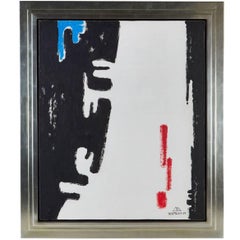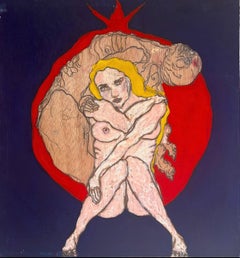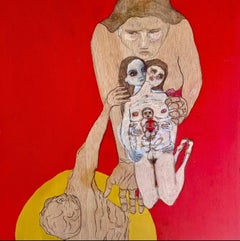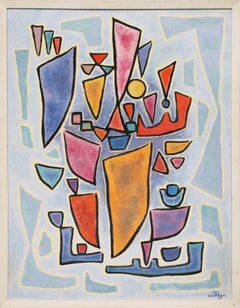Emil James Bisttram Paintings
American, 1895-1976
Emil Bisttram was born in Hungary in 1895 and emigrated with his parents when he was eleven to America. Bisttram choose a more economically promising career in commercial art design due to his economic conditions and opened his own art agency at the young age of twenty. During this time, he took classes with Leon Kroll at the Art Student League and with Jay Hambidge, an advocate of Dynamic Symmetry, at the New York School of Fine and Applied Art (renamed the Parsons School of Design). Dynamic Symmetry is a system of spatial balances and had a lifelong impact on Bisttram. Bisttram taught at Parsons from 1920 to 1925 and at the New York Master Institute of United Arts at the Roerich Museum from 1925-1930. The Institute was a spiritual inspiration to Bisttram because it advocated linking the fine arts together. However, his style of painting was more influenced by Kandinsky and he began to experiment in non-objective art.
Bisttram received many awards including a Guggenheim fellowship in 1931 to study mural painting. However, he decided to go to Mexico study with the great Mexican Muralist Diego Rivera. After returning from Mexico, Bisttram participated in an exhibition at the Whitney Museum for Guggenheim fellows in 1933 and received a commission to create a mural for the Taos, New Mexico courthouse.
The Taos School of Art (renamed Bisttram School of Fine Art) which explored spiritualism and meditation was opened by Bisttram in 1932 where he taught some famous painters, including Florence Miller Pierce. Together with Raymond Jonson and Lauren Harris, the Transcendental Painting Group was formed in Santa Fe, New Mexico from 1938-1942. This group was considered very radical for the time and the community reacted with much disdain. Nevertheless, Bisttram continued to teach and paint, and it is thought that Bisttram’s art truly represents transcendental ideas. Exhibited: Philadelphia Watercolor Club, 1926 (prize), 1931 (medal); Pennsylvania Academy of the Fine Arts, 1926-28, 1933, 1941, 1954; American Watercolor Society, 1927 (prize), 1930 (prize), 1931 (prize); Art Institute of Chicago; Corcoran Gallery, 1932, 1935; Whitney Museum of American Art, 1951; Martin Diamond Fine Art, 1984.
Works Held: Roerich Museum, New York; Albright Art Gallery; Taos County Courthouse; Department of Justice, Washington, D.C. (mural); United States Post Office, Ranger, Texas (mural).
©David Cook Galleries, LLCto
1
1
Overall Width
to
Overall Height
to
1
1
1
1
1
1
782
713
713
698
1
1
Artist: Emil James Bisttram
Original, Signed, 1959, Abstract Oil Painting
By Emil James Bisttram
Located in Los Angeles, CA
Striking, black, white, red and blue, oil-on-panel painting by listed American artist, Emil Bisttram (1895-1976) whose work is held in many important museums. This period image has b...
Category
Mid-20th Century Emil James Bisttram Paintings
Materials
Panel, Oil
$15,450 Sale Price
40% Off
Related Items
French Contemporary art By Rachel Yedid - Grenade 3 : Je te Porte
Located in Paris, IDF
Pastel & oil on wooden board
Rachel Yedid is a French multidisciplinary artist born in 1977 who lives and works between Paris, France & Jerusalem, Israel. She grew up marked by a se...
Category
2010s Contemporary Emil James Bisttram Paintings
Materials
Wood Panel, Pastel, Oil
$2,900
H 12.21 in W 11.42 in D 0.79 in
French Contemporary art By Rachel Yedid - Grenade 1 : Petite Grenade
Located in Paris, IDF
Pastel & oil on wooden board
Rachel Yedid is a French multidisciplinary artist born in 1977 who lives and works between Paris, France & Jerusalem, Israel. She grew up marked by a se...
Category
2010s Contemporary Emil James Bisttram Paintings
Materials
Pastel, Oil, Wood Panel
$2,900
H 15.75 in W 15.75 in D 0.79 in
French Contemporary art By Rachel Yedid - Grenade 2 : Naissance
Located in Paris, IDF
Pastel & oil on wooden board
Rachel Yedid is a French multidisciplinary artist born in 1977 who lives and works between Paris, France & Jerusalem, Israel. She grew up marked by a se...
Category
2010s Contemporary Emil James Bisttram Paintings
Materials
Oil, Wood Panel
$2,900
H 15.75 in W 15.75 in D 0.79 in
Cloud Study - 19th Century Oil on Paper
Located in Stockholm, SE
Cloud study by a rocky coastline overlooking the sea. To the right of the composition stands a large maritime marker, while in the lower left a few ship masts emerge in the distance....
Category
19th Century Other Art Style Emil James Bisttram Paintings
Materials
Paper, Oil, Wood Panel
1920 Cesare Ciani Credited Italian Macchiaiolo Portrait Painting
By Cesare Ciani
Located in Roma, IT
1920 Cesare Ciani Credited Italian Macchiaiolo Portrait Painting
A beautiful, intense painting attributed to the great Macchiaioli painter Cesare Ciani.
It depicts with rare realism...
Category
1920s Old Masters Emil James Bisttram Paintings
Materials
Oil, Wood Panel
$1,541
H 17.72 in W 13 in D 0.2 in
Paris Model
Located in Täby, SE
Julie Elise Hullgren, born July 29, 1879 in Aalborg, Denmark, died 1963, was a Danish-Swedish painter. She was the daughter of director J.G. Dinesen and Vilhelmine Marie Rodskier and...
Category
1910s Impressionist Emil James Bisttram Paintings
Materials
Oil, Wood Panel
Camel beach sketch
Located in CAMPO REAL, ES
In this sketch entitled “Camel Beach”, the artist transports us to the shores of Santander through carefully placed brushstrokes. With a palette of cold tones, the painting captures ...
Category
21st Century and Contemporary Realist Emil James Bisttram Paintings
Materials
Wood Panel, Oil, Linen
Still life painting of a vase with flowers (dahlias) on a silver plate
Located in Oostende, BE
Still life painting of a vase with flowers (dahlias) on a silver plate
Category
Early 20th Century Emil James Bisttram Paintings
Materials
Oil, Panel
$2,075
H 33.47 in W 30.71 in D 3.15 in
Paris
By Pierre Bergian
Located in New Orleans, LA
Pierre Bergian expresses his fascination for architecture through his paintings by exploring space and structure, making use of the presence of architectural components. His current ...
Category
2010s Contemporary Emil James Bisttram Paintings
Materials
Oil, Panel
19th Century Cesare Ciani Credited Italian Macchiaiolo Painting
By Cesare Ciani
Located in Roma, IT
19th Century Cesare Ciani Credited Italian Macchiaiolo Painting
A beautiful, intense painting attributed to the great Macchiaioli painter Cesare Ciani.
It depicts with rare realism ...
Category
Late 19th Century Italian School Emil James Bisttram Paintings
Materials
Oil, Wood Panel
$1,126
H 15.36 in W 10.63 in D 0.2 in
Sunset in a harbor
Located in CAMPO REAL, ES
In this sunset harbor scene, everything is enveloped in calm. The last rays of the sun bathe a fishing building, while the moored boats play with light a...
Category
21st Century and Contemporary Realist Emil James Bisttram Paintings
Materials
Wood Panel, Oil, Wood
Bejeweled woman within a Barbizon Landscape, 19th Century French
By Leon Richet
Located in New York, NY
Leon RIchet
Bejeweled woman within a Barbizon Landscape
1872
Oil on panel
24 x 18 inches (61 x 45.7 cm)
Framed: 36 x 30 inches (91.4 x 76.2 cm)
Signed: Léon Richet 72
Leon RIchet wa...
Category
1870s Barbizon School Emil James Bisttram Paintings
Materials
Panel, Oil
$18,000
H 35.99 in W 30.01 in
Previously Available Items
Still Life
By Emil James Bisttram
Located in Denver, CO
Housed in a vintage custom frame; outer dimensions measure 37 x 28 inches. Image measures 36 x 27 inches.
Provenance: Private Collection, New Mexico
Emil Bisttram grew up in the t...
Category
1950s Abstract Emil James Bisttram Paintings
Materials
Oil, Board
Emil James Bisttram paintings for sale on 1stDibs.
Find a wide variety of authentic Emil James Bisttram paintings available for sale on 1stDibs. You can also browse by medium to find art by Emil James Bisttram in oil paint, paint, board and more. Much of the original work by this artist or collective was created during the 20th century and is mostly associated with the abstract style. Not every interior allows for large Emil James Bisttram paintings, so small editions measuring 31 inches across are available. Customers who are interested in this artist might also find the work of Melville Price, Amaranth Ehrenhalt, and Mark Tobey. Emil James Bisttram paintings prices can differ depending upon medium, time period and other attributes. On 1stDibs, the price for these items starts at $15,450 and tops out at $27,750, while the average work can sell for $21,600.



